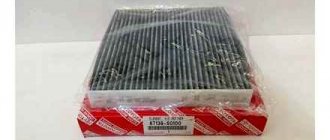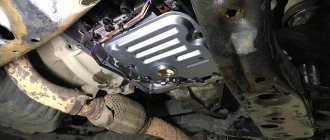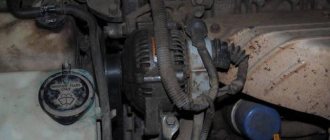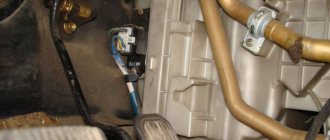Thanks to the power steering, driving the Toyota Camry 40 becomes easier for the driver.
Power steering provides better and smoother steering compared to increasingly common electric power steering systems. However, power steering repair is more complicated, as is its maintenance. Mechanism parts wear out, despite the fact that this happens much more slowly than in other cars. The steering rack most often fails. This is unpleasant, because it is the basis of the entire management system.
Sometimes, to return the control mechanism to its original mode, it is enough to tighten a few bolts, but this does not always happen. Some trust only trusted car repair shops, but in our country men are capable of much, including doing repairs with their own hands.
When and why does knocking occur?
The weak point of a car is often the steering wheel. It is here that, over time, the first problem may appear, namely, a knocking sound in the steering wheel on a Toyota Camry V40. Extraneous noises in the steering wheel, as a rule, appear after the car's mileage reaches 200 thousand km. This problem is very common, so we decided to review the most common causes of this problem and how to fix it.
A knock in the Camry V40 steering rack indicates serious problems in one of the most important parts of the car. According to the traffic rules, operating a vehicle with any problems with the steering wheel is prohibited. Therefore, if the slightest sign of a steering wheel malfunction appears, it is necessary to carry out diagnostics and appropriate repairs. A knock in the steering wheel on a Toyota Camry is an important signal of a breakdown or defect and requires immediate attention.
This is interesting: Tires for Hyundai Solaris: how to choose, sizes and pressure
How to identify a steering problem
The main type of work often carried out in a car service center is replacing the steering shaft crosspiece on a Toyota Camry 40 . Our roads are far from ideal, and, given the control design of this car model, most of the loads fall on the crosspieces.
Their malfunction is expressed in the form of a characteristic knocking sound that occurs when driving over small irregularities or turning the steering wheel. When there is strong wear on the crosspieces, play in the steering wheel occurs, which negatively affects the car’s handling and often becomes the cause of accidents.
If extraneous sounds appear accompanying the steering wheel turn, play, hydraulic fluid leakage or the steering wheel “biting”, it is necessary to carry out diagnostics and subsequent repairs without delay. This can be done either in a car service center or independently.
Procedure for replacing the shaft and crosspieces
Replacing the steering shaft crosspiece on a Toyota Camry is carried out as follows:
- The car wheels and steering wheel are set to the middle position, after which the steering wheel is carefully fixed. The fact is that the cable installed in the steering wheel, designed to connect the airbag, signal and multifunction buttons, has a limit of 2.5 turns. If you accidentally turn the steering wheel while replacing the crosspiece, the cable may break, the cost of which is quite high.
- Use a 10mm socket to unscrew the bolts on the lower crosspiece located under the hood directly next to the rack. Then on the top one, located in the cabin near the brake pedal. It is worth noting that usually the lower crosspiece fails, but if at the same time it is necessary to replace the steering cardan on a Toyota Camry 40 , then both need to be removed.
- A mounting bracket is inserted between the lower crosspiece and the rack, and with careful movements the cardan is pulled out of the socket. From the interior side, the crosspiece is knocked down with a hammer. Be careful not to damage the driveshaft splines.
Then new crosspieces are installed on the cardan or the entire assembly is changed. Everything is assembled in reverse order.
Operating principle of the steering rack
The distributor pumps infused fluid when the steering wheel is turned; in the normal position, it, directed by the pump, goes back into the tank. It is noteworthy that in this case the pressure drops to zero. The pump moves thanks to a belt placed on the engine crankshaft pulley.
Steering rack failure is a common problem in Japanese cars. Toyota Camry owners often complain about knocking in the steering wheel or leakage in the steering column. None of the problems bring happiness; the car requires urgent repair of the steering rack. Maintenance requires contacting a technical service; many problems can be resolved independently.
Replacing the steering rack
It is more convenient to remove the steering rack on a Toyota Camry 40, 30 on an overpass or a lift. The part itself is fixed with two bolts, which are quite difficult to get to without special equipment. The steering tips are pulled out of the hubs, then we proceed to the rack itself.
A little advice! To ensure that nothing interferes and the part can be repaired, remove the stabilizer. It is quite difficult to unscrew (it is located in a difficult place). The whole problem is in the bolt, which is installed close to the body, which means you have to twist it little by little. Once the stabilizer is disconnected from the rest, access to the mounting bolts is open (usually there are no problems with them).
- The bolts do not need to be unscrewed immediately, so that later it will be easier to free the cardan from the rack and remove the high-pressure hoses. We take the key for twelve and move into the engine compartment.
- There you need to find and unscrew the universal joint, then unscrew the two bolts in the passenger compartment (also 12, located at the driver’s feet).
- Now the element moves along the splines and can be detached.
Methods to get rid of knocking in the steering wheel
All vehicle mechanisms have operating time limits, including the steering wheel. This time depends not only on the quality of the part, but also on the operating conditions of the unit. The heaviest loads usually fall on the suspension, but the steering system experiences no less load, so on a Toyota Camry, knocking in the steering column is not uncommon.
Operating a car is impossible without regular use of the steering wheel, so this part of the car is the most vulnerable. If there is significant wear on the steering wheel parts, the car owner may hear a specific knocking sound in the steering wheel, but we will find out how to get rid of it later.
Let's look at the main malfunctions of the Camry V40 that cause knocking in the steering wheel and methods for eliminating these problems.
If the car is often or daily driven on an uneven road with potholes and bumps, then the steering wheel parts may fail. Most often this is a fluoroplastic bushing. This spare part wears out over a long period of use, causing knocking and loose connections.
On a note! A sign of bushing failure is the appearance of unusual rattling and vibration, which is most strongly felt when the steering wheel is in a straight position. When making turns, a characteristic hum may appear. The appearance of these signs indicates a possible imminent failure of other parts of the steering wheel, and therefore can lead to breakdown of the entire control mechanism.
Dismantling and installation of a new bushing
In order to eliminate a knock in the steering column on a Toyota Camry V40, it is necessary to replace the broken part. This is a simple manipulation, you can handle it yourself. To do this you need:
- Remove under the steering guard by unscrewing all the fasteners.
- Remove a section of the air duct to open the path to the column itself.
- Remove the column itself and place it on a flat surface with the steering wheel facing down.
- Remove the old bushing; to do this, you can screw a couple of screws into it, cover the steering wheel, rest your knees on the steering wheel and pull out the part, holding the screws with pliers.
- Clean and lubricate the shaft.
- Install a new bushing.
how to tighten the rack?
In general, the rack is loose, trembles when braking, on uneven roads, and sometimes on even ones too. About a month ago they removed the seals and changed them (I didn’t do it myself). Now you have to apply different forces in different turns, the slurry is light. Everywhere in the posts I saw people recommending extending it. I want to do it myself but I don’t know how. In theory, there should be 2 nuts somewhere, one of them is eccentric.. or I’m not catching up at all)) help the ignoramus)
if you look from behind, there is a bolt in the middle of the rack (I could be wrong, but in my opinion it’s 12), tighten it all the way and 30-45 degrees back, by analogy with the auto basin.
Camry ACV 40 2008
One person saw it coming.
Isn’t it tightened with a hex plug (like 24, or something..), the one that is locked, at the bottom, under the valve block, above the cross beam? Something like this came up in discussions about the rail... Look in Search, it must be...
Yes, with a cork, just don’t squeeze it.
A garage mechanic tightened the rack for me for 200 rubles. For this you need special keys (it’s inconvenient there) and a lift, the steering wheel has become a little heavier, knocks and play have disappeared. The master himself said that it would not last long.
fact, if you tighten the steering wheel it will bite. there literally, even less than half a turn is needed. and it was correctly noted that it is very inconvenient there. You need a tool. I wouldn't go there myself if I were you
Well, you don’t need a special tool... I found a bolt with a 24mm head, cut it off and welded the lever. It turned out to be an L-shaped wrench.. So I used it to tighten it, a little bit..))
You can do this, or you can put a nut of the appropriate caliber and a spanner there. and I unlocked and counter-locked it back with the help of a chisel and a hammer - it took about 5 minutes, just advice - so as not to suffer for a long time and not have to look for where this line is, how long to tighten this nut so that it doesn’t bite - jack up the car from the front and turn the steering wheel, try (with the car turned off, of course)
Yes, I thought about doing it too. another question. I have knocking noises when I turn left to right somewhere under my left foot and on the right closer to the counter. and when I’m driving on the road, in addition to play, there is the following symptom - the steering wheel jerks from left to right (as if it’s hitting it), literally 10 degrees up and 10 degrees down (well, that is, from right to left), in theory I’ll stretch the rack and this symptom will go away??
Well, no one can tell you if the steering wheel moves from left to right as I wrote.. which plug to tighten and what else to look at.. tomorrow the lift is knocked out.. I’ll go exercise..
If the steering wheel is shaking, then I would be in your place: 1. Check the cutting 2. I went to a normal wheel alignment stand. 3. At PCX, for a couple of hundred, if you’re not completely redneck, they’ll tighten up the rack for you.
In general, I climbed in and took a look. The rod ends are normal, the driveshaft does not play, it knocks cleanly in the middle of the rack, oil flows from everywhere it can flow. there was play in the steering wheel. I also changed the hydraulic belt (otherwise the steering wheel was spinning heavily). I tightened the bolt that is closer to the engine, but didn’t touch the one that faces back - it didn’t fit. As a result, what we have is that there is no more play, the knocking sound has become more muffled (but remains), the steering wheel has become hard and does not completely go away after turns. It still hits the steering wheel from right to left, but it has become less frequent. I assume it’s the rack that hits.. when you turn the steering wheel there’s an unreal blow to the right tip (I tried it with my hand), hence I think there’s a knock on the right when the steering wheel is turned to the right.. in general, I’m looking for a contract for the rack. Can you tell me who I can order through? I'm from Tyumen myself. price tag 4 rubles here. I think it’s a little expensive for a car of this year.. what do you think about the price tags?
Rail repair and replacement
If, after installing new crosspieces, knocks and play in the steering wheel do not disappear, then the cause of the malfunction may lie in wear of the steering rack mechanism. The manufacturer provides the possibility of adjustment: near the entry point of the cardan there is a hexagon bolt. Turning it clockwise ensures a tighter fit of the parts in the rack mechanism, but this type of repair is a temporary measure and has its drawbacks. The fact is that when the adjusting bolt is tightened, the steering becomes noticeably “heavier”, to the point of biting the steering wheel in extreme positions.
Therefore, if the rack malfunctions, the best option would be to replace the steering mechanism with a Toyota Camry . This is done like this:
- The car is driven into a pit or overpass; in extreme cases, its front part is jacked up and hung out.
- The high pressure hoses are unscrewed. A container for draining the working fluid should be prepared in advance. It is not recommended to pour used hydraulic oil back into the system after repair - it is better to buy new one.
- The steering tips are turned away from the hub of the front wheels. It is not recommended to unscrew them from the rods located on the rack - otherwise the camber of the front wheels will need to be adjusted.
- To facilitate access to the bolts securing the rail, the stabilizer is unscrewed and removed.
- The lower crosspiece of the cardan is unscrewed. replaced the steering shaft crosspiece on a Camry 40 before , now is the time to do it.
- Unscrew the 2 bolts securing the rack. Since there is little space to turn the wrench where the bolts are installed, this operation can take a long time.
- The rack is removed and sent for repair, or a new one is installed instead.
- Everything is assembled in the reverse order; fluid is poured into the power steering through the reservoir.
On average, work to replace the steering mechanism takes no more than one day. Repairing the slats usually takes much longer and should only be performed by specialists.
- Tweet
- Share 0
- +1
- LinkedIn 0
How power steering works in a Toyota Camry
The hydraulic booster includes the following parts:
- power steering pump driven by the car engine;
- power steering expansion tank;
- steering rack.
Hydraulic oil with a low viscosity is used as the working fluid. Depending on the manufacturer, different types of lubricating fluid are used; in some cases, ATF-2 or ATF-3 is used, which is also poured into the automatic transmission.
The rotation of the steering wheel is transmitted to the rack using a steering shaft (cardan), with crosspieces installed on both sides of it. Thanks to them, it is possible to adjust the position of the steering wheel.
Important!
Driving on unbalanced wheels creates high vibration loads on the steering, which leads to wear on the driveshaft and crosspieces, and in the future the steering shaft may need to be replaced on a Camry 40 body.
Briefly, the work of the power steering is carried out as follows:
- when the engine is running, the power steering pump creates high pressure in the system, reaching 8–9 MPa;
- When the steering wheel is turned, working fluid is pumped under pressure into the rack cylinders, greatly increasing the forces transmitted to the steering rods.
A special valve is installed on the rack, allowing hydraulic oil to flow into the working cylinders when the steering wheel is turned. When it is in the central position, the valve is completely closed and the working fluid circulates freely throughout the system.
Why choose us?
1 Free diagnostics
2
Repair of steering wheel of any brand within a few hours
3
Warranty up to 2 years











